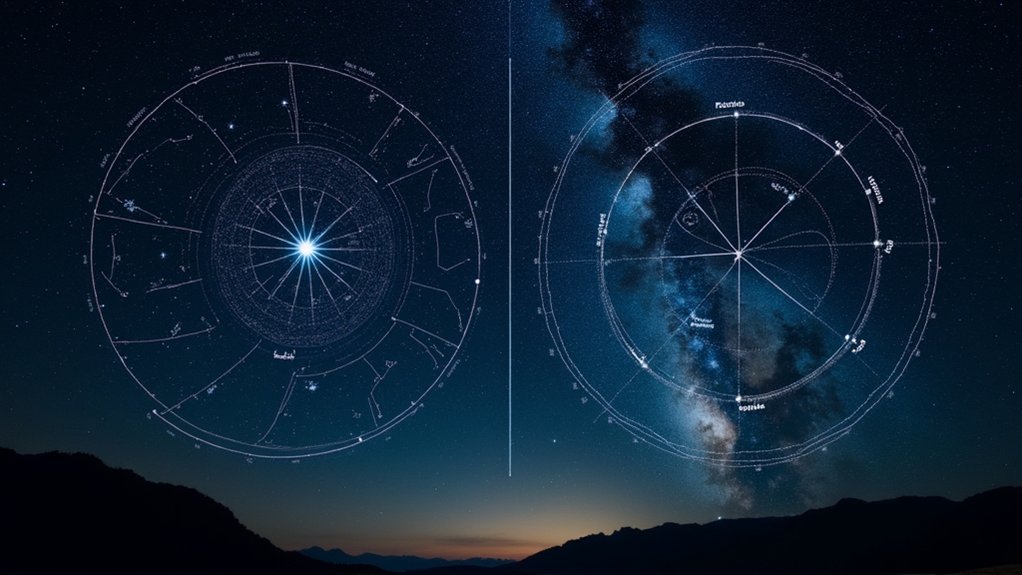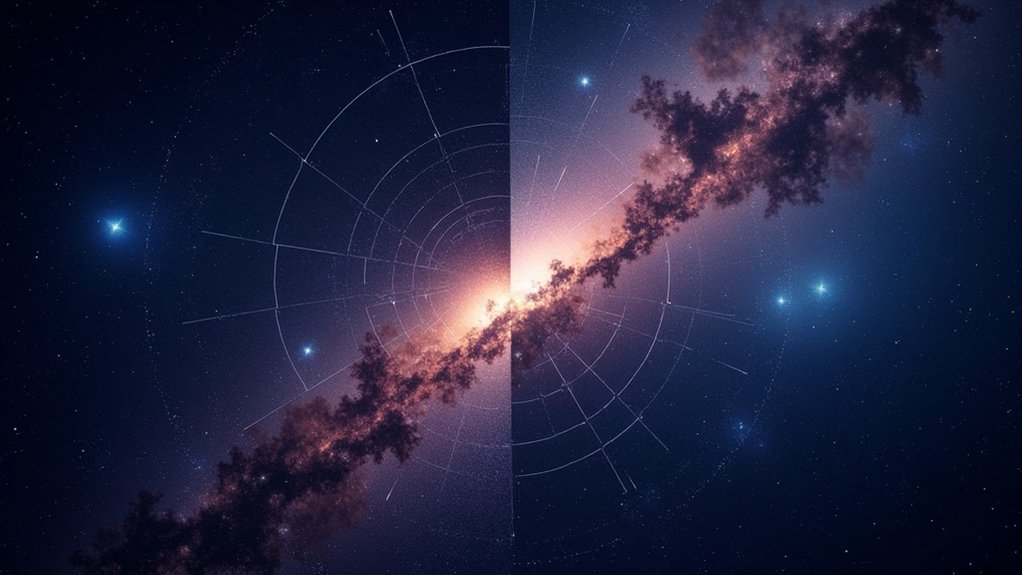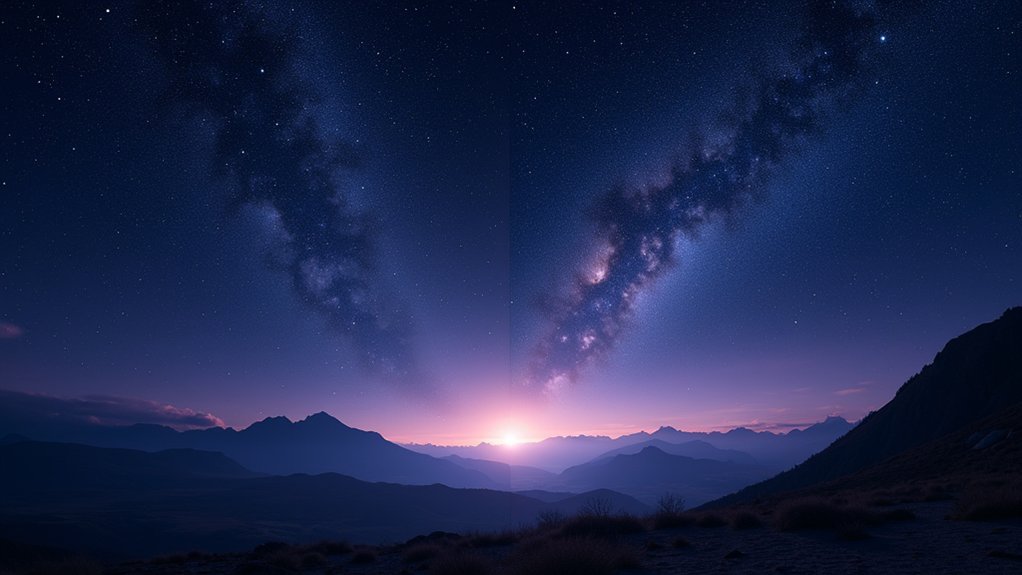Northern and Southern Hemisphere sky maps differ in seven key ways: pole stars (Polaris vs. faint Sigma Octantis), inverted constellation orientation, hemisphere-exclusive objects (Southern Cross vs. Big Dipper), Milky Way center visibility (better in south), navigation techniques, deep sky object distribution, and ideal viewing conditions. Your location dramatically changes what you’ll see overhead, with Southern skies offering spectacular views of the Magellanic Clouds and galactic center that Northern observers miss. Discover how these differences transform your stargazing experience.
Hemispheric Pole Stars: Polaris vs. Sigma Octantis

When comparing navigational guides in the night sky, the northern and southern hemispheres offer dramatically different experiences.
If you’re in the northern hemisphere, you’re fortunate to have Polaris, a bright star positioned almost directly above the North Pole. With its coordinates at right ascension 2h 31m 49s and declination +89° 15′ 51″, Polaris provides reliable year-round navigation.
Polaris stands sentinel above the North Pole, a celestial lighthouse guiding nighttime travelers with its steady brilliance.
Southern hemisphere observers face a greater challenge. Sigma Octantis, the South Star, sits near the South Celestial Pole but is notably fainter than its northern counterpart. Located at right ascension 21h 58m 34s and declination -89° 99′ 25″, it’s only visible from locations south of the equator.
This disparity between pole stars creates distinct navigation techniques across hemispheres—northerners rely on Polaris’s prominence while southerners must adapt to Sigma Octantis’s subtlety.
Seasonal Constellation Orientation and Appearance
When you look at familiar constellations from the Southern Hemisphere, you’ll notice they appear upside-down compared to their Northern Hemisphere orientation, creating a distinct stargazing experience.
This inversion affects how you’ll recognize patterns like Orion, whose sword points upward toward Rigel when viewed from Australia or South America.
Charting these inverted celestial views presents unique challenges for astronomers and hobbyists who travel between hemispheres, requiring adaptation to the altered seasonal visibility and appearance of star clusters.
Inverted Celestial Views
Though many astronomy enthusiasts are familiar with the northern night sky, those venturing to the Southern Hemisphere will discover a dramatically different celestial landscape.
When you observe familiar constellations from below the equator, they appear completely inverted compared to their northern orientation, creating a unique visual experience.
The Southern Hemisphere offers several distinct advantages:
- You’ll have a prime view of the South Celestial Pole, which points toward the Milky Way’s galactic center, offering richer stargazing opportunities.
- Iconic southern constellations visible year-round include the Southern Cross (Crux) and the Southern Pointers, which aren’t observable from northern latitudes.
- The Milky Way’s bright center is ideally positioned for viewing from June to September, presenting a spectacular display absent in northern skies.
Cross-Hemisphere Stargazing Challenges
Travelers crossing from one hemisphere to another face distinct astronomical disorientation as familiar celestial patterns take on unfamiliar orientations.
When you venture into the southern hemisphere sky, you’ll discover that constellations appear “upside down” compared to northern views. Orion seems to stand on his head, while the Summer Triangle transforms into the Winter Triangle.
Navigation presents a particular challenge—without Polaris visible, you’ll need to rely on the Southern Cross for orientation. Your familiar star charts become fundamentally useless without mental reorientation.
Even timing changes, as circumpolar stars differ between hemispheres, altering which constellations remain visible year-round.
The seasonal appearance of constellations also reverses, meaning northern winter constellations become southern summer highlights.
This celestial inversion requires adaptability and a willingness to relearn the night sky from a new perspective.
Exclusive Celestial Objects in Each Hemisphere

Each hemisphere offers skygazers its own collection of celestial treasures that can’t be fully appreciated from the opposite half of the globe. The Southern Hemisphere boasts particularly spectacular views that northern observers might envy.
- Unique constellations like the Southern Cross (Crux) and the adjacent Coalsack Nebula provide distinctive navigational markers and photographic subjects you’ll never spot from northern latitudes.
- Alpha Centauri, our nearest stellar neighbor at just 4.37 light-years away, and brilliant Canopus (the second brightest star in our sky) remain hidden from most northern observers.
- Deep sky objects in the south include the magnificent Magellanic Clouds—dwarf galaxies visible to the naked eye—and the breathtaking Omega Centauri globular cluster with its 10 million stars.
Milky Way Visibility and Galactic Center Exposure
When it comes to viewing our galaxy’s most spectacular features, Southern Hemisphere observers have a distinct advantage. The South Celestial Pole points directly toward the Milky Way’s galactic center, offering an unrivaled view of our galaxy’s core that Northern Hemisphere stargazers simply can’t match.
From June to September, you’ll find ideal conditions in the Southern Hemisphere for observing the bright galactic center, with its rich star fields and deep-sky objects. The Teapot asterism in the Sagittarius Arm serves as an excellent naked-eye reference point for locating other celestial wonders.
Southern skies also reveal the dramatic Coalsack Nebula near the Jewel Box Cluster, along with the impressive Tarantula Nebula in the Large Magellanic Cloud—features that make Southern Hemisphere Milky Way viewing truly extraordinary.
Star Chart Reading and Navigation Techniques

Traveling through the night sky effectively requires understanding the fundamental differences between Northern and Southern Hemisphere star charts.
When you cross the equator, familiar constellations appear inverted, creating a disorienting experience for unprepared observers maneuvering the celestial sphere.
To master star chart navigation across hemispheres:
Cross-hemispheric star chart mastery demands perspective adjustment, proper planisphere selection, and dedicated practice with celestial coordinates.
- Adjust your perspective when switching hemispheres – southern star charts display constellations upside-down compared to northern maps.
- Learn to use planispheres specific to your hemisphere by aligning the current date and time to reveal visible stars for your location.
- Practice star hopping in both hemispheres, using bright reference stars as signposts to locate fainter objects while paying attention to the coordinate system of declination and right ascension.
Understanding local geography and seasonal sky changes will greatly enhance your stargazing experience regardless of hemisphere.
Deep Sky Object Distribution Between Hemispheres
Beyond mastering star chart navigation techniques lies the remarkable disparity in deep sky object abundance between hemispheres. The southern hemisphere constellation regions overwhelmingly outshine their northern counterparts in both quantity and brilliance of celestial features.
You’ll find the southern skies blessed with spectacular globular clusters like Omega Centauri and 47 Tucanae, visible even without telescopes.
From June through September, you’re treated to the Milky Way’s brilliant center, showcasing the Sagittarius Arm and Coalsack Nebula with unmatched clarity.
The Large and Small Magellanic Clouds—dwarf galaxies orbiting our own—are exclusively southern hemisphere treasures, best observed October to February.
Deep-sky objects like the Jewel Box Cluster, Tarantula Nebula, and the potentially explosive Eta Carinae Nebula further demonstrate why southern skies offer astronomers the most breathtaking celestial landscapes.
Light Pollution and Optimal Viewing Conditions
The Southern Hemisphere boasts exceptional Dark Sky Sanctuaries like the NamibRand Nature Reserve and Atacama Desert, where minimal light pollution reveals celestial wonders invisible from urban areas.
If you’re confined to city viewing, you’ll need specialized techniques such as timing your observations during moonless nights and using light-blocking shields to maximize visibility.
You’ll experience the best southern sky views between March and September when the Milky Way’s brilliant center dominates the night, appearing to glow rather than twinkle in ideal atmospheric conditions.
Dark Sky Sanctuaries
While light pollution increasingly engulfs urban centers worldwide, Dark Sky Sanctuaries stand as bastions of pristine celestial visibility.
These designated havens protect the night sky, offering you unprecedented stargazing experiences free from artificial light interference.
- The NamibRand Nature Reserve in Namibia holds a prestigious gold-rated International Dark Sky Park status, where you’ll witness some of Earth’s clearest night skies.
- Mashatu in Botswana provides exceptional viewing conditions with its remarkable 92% rain-free nights and complete absence of light pollution.
- High-altitude sanctuaries like Chile’s Atacama Desert offer unique observations where stars glow rather than twinkle due to the thinner atmosphere.
Urban Stargazing Techniques
Not everyone can travel to remote Dark Sky Sanctuaries, but you’ll find that meaningful stargazing remains possible even amid urban glow.
To maximize your urban stargazing experience, seek locations with minimal light pollution, such as local parks away from streetlights or designated dark sky areas within city limits.
For best viewing conditions, time your observations during new moon phases when the sky is naturally darker.
Consider using specialized light pollution filters on your equipment to improve contrast and reduce artificial light interference.
You’ll also benefit from elevated vantage points—hilltops or tall buildings—which position you above much of the city’s light dome.
Early morning hours or just after sunset often provide clearer urban skies as commercial lighting diminishes and air pollution settles.
Frequently Asked Questions
What Is the Difference Between the North and South Sky?
You’ll see upside-down constellations in the Southern Hemisphere compared to the Northern. You can’t see Polaris from the south, but you’ll enjoy unique sights like the Southern Cross and Alpha Centauri instead.
What Are the Major Differences Between the Northern and Southern Hemispheres?
You’ll notice opposite seasons between hemispheres, with winter occurring June-August in the south. The southern sky features unique constellations like the Southern Cross, while the north has Polaris and the Big Dipper.
Why Are East and West Reversed on a Star Map?
East and west are reversed on star maps because you’re looking up at the sky, not down at the ground. When you hold a map overhead, directions naturally flip to match your perspective of the celestial sphere.
Do You See Different Stars in the Northern and Southern Hemisphere?
Yes, you’ll see entirely different stars in each hemisphere. The Southern Cross and Alpha Centauri are visible only from the south, while Polaris and the Big Dipper can only be seen from the north.
In Summary
You’ve now discovered the key differences between hemisphere sky maps. Whether you’re steering by Polaris or Sigma Octantis, you’ll experience unique constellations, celestial objects, and Milky Way views depending on your location. You’ll need different chart-reading techniques for each hemisphere, and you’ll find varying deep sky object distributions and light pollution conditions. Armed with this knowledge, you’re ready to explore whichever celestial hemisphere you’re under.





Leave a Reply